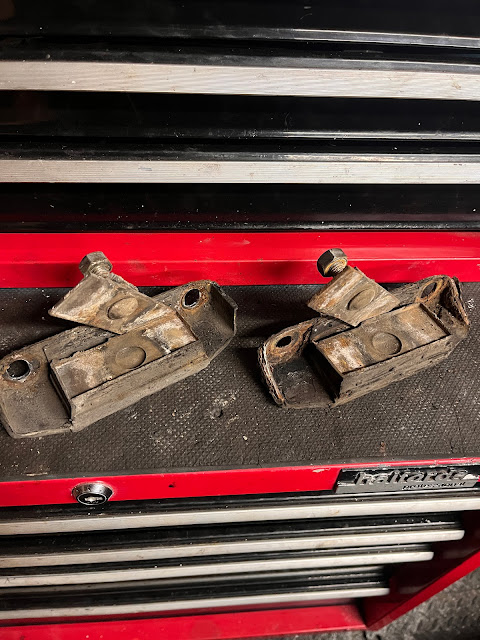Rear Suspension Removal
The brake disks and hand brake mechanism needed to come off as I was not disconnecting and replacing the handbrake cable, especially as I had already pulled up the carpet and glued it back down as part of the rust prevention process I did earlier. The rear callipers and discs came off as expected, but the hand brake is a little different as it used shoes inside the rotors 😕 Pelican Parts have a guide for the parking brake shoe replacement, which I found helpful as I could not for the life of me get the brake shoes off.
The drive shaft was quickly removed from the gearbox and, unlike front-wheel drive cars dropped straight down, clearing the gearbox. Both CV joints on the drive shaft had excessive play and needed replacing. The gearbox output shaft seals were also badly worn and needed replacing, as the whole area was covered in gearbox oil.
The driver-side swing arm did not come off easily, the arms are alloy, and the bolts are steel, so they corrode and feel like they have been welded in place. Heat is needed to get these out cleanly, and because the alloy soaks up a lot of the heat, you need to heat the points the bolts mate with the alloy up for much longer.
Bolt 31, from the diagram below, snapped off in place. I think this is because I tried to undo the bolt rather than the nut at the back, so I recommend staring at the back, and if the bolt is stuck in place, deal with it once the arm has been removed from the spring plate and away from the car. I used heat and the pipe wrench to remove the leftover stud.
The three bolts you need to take off can be viewed using the diagram above and below. The bolt 30a connects through the arm, spring plate and ARB drop link. This is also difficult to get out because it seizes into the rubber bushed of the drop link. I found heating the rubber was the easiest way to deal with this and factoring in replacing the bushes with PowerFlex bushes or rose jointed drop links
Removing the bolt that goes through the shock and into the swing arm was the most challenging part of this job. The bolt was solidly in place, my 800nm impact wrench was just stalling and engaging the clutch and cutting out. When I tried to loosen it with a strong arm bar, it felt like the would pull the car off the axle stands. I tried removing the swing arm with the shock attached and applying heat and removing it, but that also did not work.
I ended up cutting the bottom lung of the shock open and removing the rubber bushing and found that the metal sleeve on the shock that the bolt goes through had corroded into the swing arm and the top of the bolt. After applying heat to the point where the sleeve and arm meet, the impact wrench easily spun the bolt out.
The exhaust does not need to be removed to remove the passenger side swing arm, but since the torque tube was also coming off the car and I was planning on fitting a new stainless steel exhaust, I took it off.
The passenger side swing arm removal was similar to the driver side, and while none of the main bolts broke off or was seized in place, two of the smaller 10mm bolts that hold the brake disc dust shield snaped off. I also found that the hand brake mechanism on this side of the car had seized, causing the rear brake to bind, which I noticed when I was driving back from the MOT centre.
Both rear bearings were shot in the swing arms, and hubs could be easily rocked by hand. These would need replacing and as they must be pressed in. I may need to visit an engineering shop to get them sorted.
Pulling the bearing race was easy using the screw fix "once use only" inner bear puller at £19.99 a pop. The metal the threaded bars are made of is so cheap if you look at them funny, the thread crosses. I used a chisel and a lump hammer to finish the other side.
The rear axle carrier was not easy to remove as the passenger side main bolt bearing flange bolt (no. 19 in the diagram below) connecting the flange to the car was seized. This had to be cut out using two cuts on either side of the bushing with a reciprocating saw and a new Milwaukee carbide-toothed blade.
Bolt 17 was also problematic to remove as it ran through an alloy spacer that had seized the bolt in place. This bolt snapped and had to be removed with heat and a pipe wrench. Even with the head of the bolt snapped off, the flange could not be removed as the spacer fused the two parts together.

















